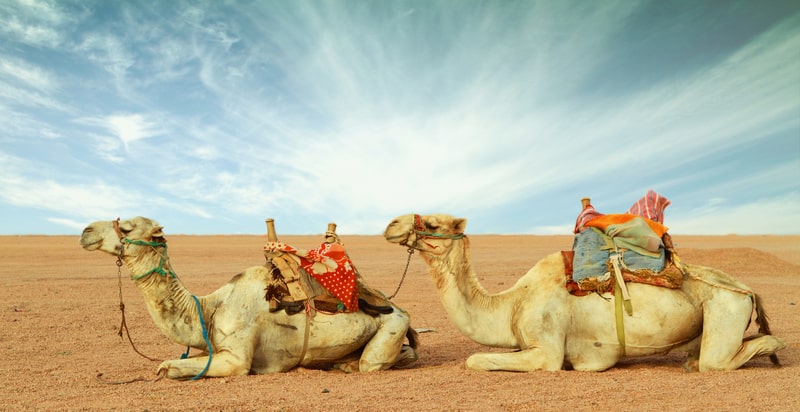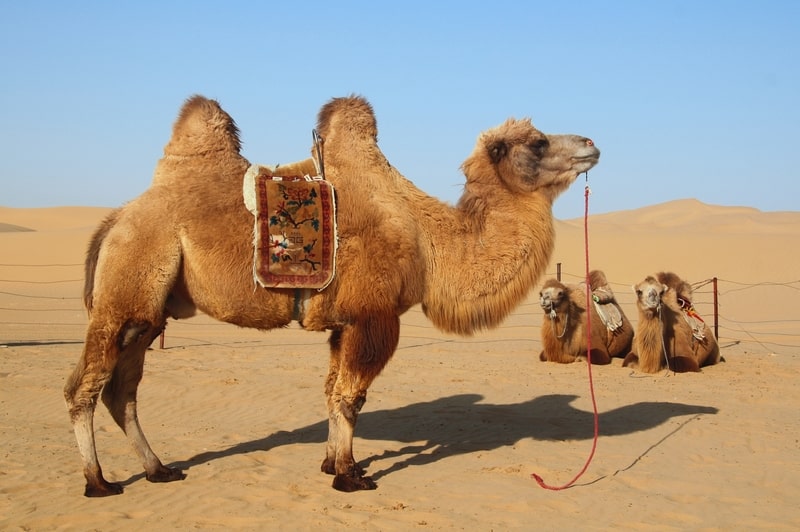Last updated on May 13th, 2023
Camels are the ships of the desert. These colossal creatures can stand 8 feet high, span 12 feet long, and weigh up to 2,200 pounds. They can bear heavy cargo on their humped backs, helping people transport goods for commerce and conquests. Their physical adaptations ensure survival even in the harshest conditions imaginable. Communities also depend on them for food, shelter, and clothing. Camels have been reliable human companions for millennia, creating a solid bond embedded in cultures and traditions. Read on to learn 50 interesting facts about camels.
Evolution
1. Camel ancestors came from North America. Around 50 million years ago, the rabbit-sized Protylopus roamed South Dakota and fed on soft forest plants. The hind legs of this hooved animal were longer than the front.
2. Then came the deer-sized Poebrotherium, which looked more like modern camels. The grass-eating beast lived in Nebraska and surrounding regions. The 10-foot tall Aepycamelus appeared later, walking on its toes from Montana to Florida.
3. We think of camels as desert dwellers, but their ancestors ventured as far north as the Canadian High Arctic. A forest covered the region around 3.5 million years ago. It was not as cold as today, but they likely experienced harsh winters with snowstorms and subzero temperatures.

4. Modern camels trace their roots to the Paracamelus. About 7 million years ago, the adventurous creature migrated from North America to Eurasia by crossing the Bering land bridge. It reached as far as Chad in Africa and Shanxi Province in China.
5. While their descendants thrived in other continents, the original wild camels of North America vanished about 15,000 years ago, along with mammoths and sabertooth cats. Only distant relatives survived in South America, including llamas, alpacas, guanacos, and vicunas.
Anatomy
6. Camel legs are long and powerful. These thin poles put ample distance between their bodies and the hot ground, which may reach 70 degrees Celsius. Their gait prevents them from sinking into the sand, spreading their weight to maintain balance.
7. Thick coats are not exclusive to arctic animals. Camels cover their bodies with substantial insulation. It turns into a lighter shade in the summer to reflect more light and reduce surface heat.
8. Camels can survive up to 10 days without drinking. Their humps store fatty tissue that can metabolize into water and energy. The humps shrink in size as they consume the fat.
9. The red blood cells of camels are oval, not circular. The streamlined shape ensures steady flow despite dehydration. It also prevents rupture after drinking large amounts of water. Some camels may consume 200 liters in as fast as 3 minutes.

10. Sandstorms are common in the desert. Camels cope by closing their nostrils and third eyelid until these subside. They also have long eyelashes and thick ear hair, providing extra protection against tiny particles.
11. A leather lining in their mouths helps camels chew thorny desert plants. In mild conditions, they can get enough hydration by eating greens. They don’t need to drink water separately.
12. Camels are lean and mean water recycling machines. When they exhale, their nostrils trap the water vapor in the expelled air and reabsorbs it into their body. Every breath counts.
13. Camels rarely sweat. When they pee, the urine comes out as a thick syrup. When they poop, the solid waste is so dry it can fuel a fire. Hence, they only lose 1.3 liters of water daily, whereas other livestock loses up to 40 liters.
14. Passive cooling works wonders. Camels have a thick pad of tissue over their breastbone. It raises the body from the hot surface when resting on the ground, allowing air to pass under the body and cool them down.
15. Brain temperature management is critical. Camels keep their heads cool using countercurrent blood flow in nearby veins and arteries called rete mirabile.

Behaviors
16. Camels may look haggard from time to time. Up to five pounds of fur peel off in late spring. After washing, people can spin the hair into yarn suitable for knitting or weaving.
17. Camels are docile creatures that don’t usually harm people. However, they may kick or bite when annoyed. Adults have wide mouths that can fit a human head.
18. Unpleasant habits like sudden sneezing can turn off passersby. Excited camels huff so sharply that they often spit. They may even regurgitate and throw up on people if threatened.
19. Camels are not picky eaters. After all, they live in regions where food is scarce. They consume things that others avoid, like dry leaves, saltbush, and salty water. They overeat when food is abundant to form their fatty humps.
20. Males establish dominance through skirmishes. They circle each other with low heads, waiting for an opening to bite or topple their opponent. Winners roll on the ground to celebrate their victory.
Reproduction
21. Camels live up to the age of 50 in captivity. These social animals stay together in herds of females led by a single mature male. Young males may also form a bachelor herd. When they meet, they greet each other by blowing air on their faces.
22. A female in heat may attract several males. Only the fittest bulls earn the right to reproduce. Some males have an inflatable sac on the throat that attracts females and asserts dominance.
23. Camel pregnancy lasts between 12 and 14 months. Mothers move away from the herd to find a private spot to give birth. They often have only one baby at a time, but some may have twins.

24. Newborn camels can walk within 30 minutes. However, they are still weak and timid. The mother and her baby will remain in their spot for two weeks before rejoining the herd. Young camels reach maturity at the age of 7.
25. Mothers may reject their calves for various reasons. Babies cry out for food and attention, but it doesn’t always work. The weeping camel may starve unless the mother changes her mind, often through human intervention.
Food Consumption
26. Camel milk is a complete meal. Nomads can survive solely on this drink for nearly a month. Dairy farming with camels is an eco-friendly alternative to cows. Some can produce up to 30 liters of milk per day.
27. Different regions process camel milk into other dairy products, like yogurt, butter, cheese, and ice cream. In Sudan, tribes ferment and pulverize surplus milk for long-term storage. When food is scarce, they add water to create a nutritious drink.
28. Camel meat is rich in protein and vitamins. It tastes like coarse beef and can be tough to eat. It requires a long tenderizing process. Ancient Persians and Romans enjoyed the meat at banquets.
29. In Northern Kenya, pastoral communities drink camel blood with milk. The mixture provides iron, salts, and essential nutrients. High levels of Vitamin D also encourage bone growth.
30. In Australia, camel meat is popular among East African migrants. They export the product to the Middle East, the US, and Europe. Some companies also use camel milk in cheese and skincare products.
Random Facts

31. Only three species of camel remain. The one-hump Dromedary camels are in the Middle East, the Sahara Desert, South Asia, and Australia. The two-hump Bactrian camels live in Central Asia, while the Wild Bactrian camels thrive in the remote areas of China and Mongolia.
32. In the 1800s, Australia imported camels from Asia for outback transport. Machines made them obsolete, prompting release into the wild. The lack of natural predators allowed their population to reach hundreds of thousands, causing ecological and agricultural damage. Culling has become a controversial solution.
33. Climate change is coming for the camels. Camel herding is central to Somali culture, but a series of cyclones and severe droughts are taking their toll. Livestock depletion is forcing herders to consider alternative livelihoods for their families.

34. The Cariboo Gold Rush of the 1860s brought countless prospectors to Canada. The rough terrain made travel difficult. Some people brought camels from the Gobi desert to carry supplies. The handlers and animals didn’t get along, so the camels soon found themselves in the wild.
35. Camel caravans carried commerce on their backs. From antiquity to the early 20th century, these animal trains moved goods and passengers on established trade routes like the Silk Road, the Arabian Peninsula, and the Sahara Desert. Some had as many as 20,000 camels, accompanied by a team of handlers.
Culture and Religion
36. Although Muslims consider camel meat halal, a few Islamic schools say consuming it brings impurity, requiring ritual cleansing before prayer.
37. According to Islamic texts, the Prophet Muhammad (P.B.U.H.) migrated from Mecca to Medina with his camel. Upon reaching their destination, he let the camel roam. He eventually built his house on its chosen resting spot.

38. Jewish tradition prohibits the consumption of camel milk and meat. Camels do not pass one of the kosher criteria according to the Torah. Despite chewing their cud, they don’t have full cloven hooves.
39. Researchers found 8,000-year-old life-size camel sculptures carved into rocks in Saudi Arabia. Many are high above the ground, which means creators used scaffolding. Nomadic tribes might have used art to mark their meeting place. These are much older than the Pyramids at Giza, which are only 4,500 years old.
40. In Siberia, archeologists found some of the earliest drawings of animals on a five-foot mammoth tusk. The 13,000-year-old artifact featured fighting camels, with the images consistent with cave paintings of the era.
Camel Competitions
41. Camel pageants are widely held across the Middle East. Candidates parade wearing jewels and gems while judges consider their lips and humps. The prize and prestige pushed owners to try questionable tactics, but cosmetic enhancements like Botox injections have resulted in disqualification.

42. Camel milking competitions usually accompany beauty contests. It is a more functional affair, with the top prize going to the animal which produces the most milk within the allotted time.
43. The centuries-old sport of camel racing used to favor child jockeys for lighter loads. Remote-controlled robotic whips now ride the humps in the UAE and Qatar. Camels can sustain 40 kph and reach 65 kph for sprints.
44. Wild camel wrestling is a natural part of dominance display. Ancient Turkic tribes turned it into a sport over 1,000 years ago. The Turkish government discouraged the practice in the 1920s, but it experienced a cultural resurgence in the 1980s. Most of the fighting camels today come from Iran and Afghanistan.
. . . continue reading on the next page
